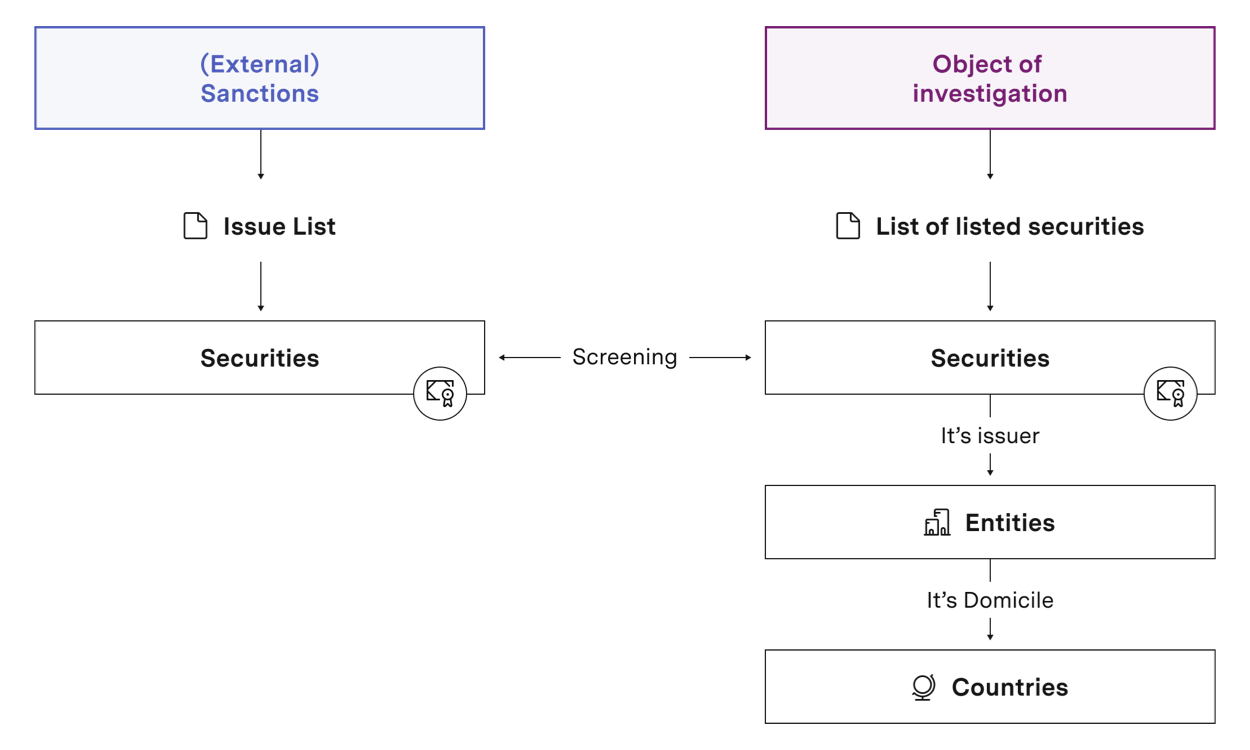Sanction Screening for Financial Instruments
How does Asset Sanction Screening reduce a bank's exposure to risk?
Asset Management departments in the financial services industry must ensure they do not hold any sanctioned positions or investments and that they do not cooperate with any sanctioned parties, whether that be a legal entity or an individual. Sanctions are restrictions imposed by governments or international organisations on countries, individuals, or entities, typically for reasons related to national security, foreign policy, or human rights concerns.
Generally, lists of sanctions are hosted in commercial databases available through trustworthy service providers for press, company, and business information.
In addition, Asset Management departments must be careful not to invest in entities, or cooperate with legal entities or individuals, that are domiciled in internationally restricted countries.
What is the scope for Sanction List Screening of Assets?
To comply, and limit their exposure to risk, organisations need to screen or investigate assets (known as objects) and take appropriate action which can involve freezing assets, blocking transactions or restricting business activities.
The Objects of Investigation may differ from business case to business case. Therefore the following checks have to be performed for each transaction:
Is a specific security or instrument affected by explicit or implicit sanctions?
Is a legal entity (e.g. issuer, counterparty, contracting party) affected by explicit or implicit sanctions?
Is an individual affected by explicit sanctions?
What is the process for investigating objects with identifiers?
Investigating financial instruments that have recognised identifiers, such as listed securities with unique identifier numbers like ISIN or CUSIP, is simpler than investigating those without identifiers. This is because the listed securities can be verified against an externally provided Issue List at the instrument level. The verification process involves comparing the unique identifier in the Object of Investigation with a list of listed securities, based on their similarity scores.
What is the Process for investigating objects without identifiers
Investigating objects without recognised identifiers is more complicated as there is no external Issue List available. Such objects may include securities or real estate asset classes such as:
Contract-based investments refer to financial instruments that do not have a recognised identifier, such as OTC derivatives or cash accounts. In order to verify these investments, it is necessary to compare the legal entities involved in the investment (such as the issuer, counterparty, or contracting party) with the service provider's Issuer List.
Cooperation parties refer to legal entities with which a bank has a cooperation agreement, but does not hold any positions or investments in those entities. Examples of such entities may include data providers and brokers. In order to verify these parties, it is necessary to compare the entity with the service provider's Issuer List.
Tenants, in the context of real estate, refer to either individuals or legal entities. When screening individual tenants, it is necessary to refer to the official List of Sanctioned Individuals. For legal entities, it is necessary to use the service provider's Issuer List to conduct the screening process.
What are the Solutions for Sanction Screening of Assets?
Sanction Screening solutions are designed to conduct transaction monitoring, including both pre-trade and post-trade checks for all transactions. For listed securities, pre-trade checks can be integrated with real-time interfaces in the portfolio management systems, while for post-trade checks, objects of investigation will be screened via a file upload or batch interface.
The compliance process for asset management will be divided into two phases: a screening phase and a verification phase.
The screening phase involves automated screening for objects of investigation with a resulting list of flagged "sanctioned" matches.
In the verification phase experts will manually verify, whether the positive results from the screening phase are true positives or false positives. True positives will trigger appropriate action being taken, while false positives will be documented and white-labelled to prevent recurring false positives.
When solutions or platforms lack robust transaction monitoring, name screening, and predictive analytics capabilities, they may generate an excessive number of false positives or fail to detect actual positives when the model's analytical accuracy is not optimised.
What are the benefits of Sanction Screening Assets?
Identify potential risks of a portfolio: Asset Sanction Screening identifies potential risks associated with investing in a particular asset or security, creating red flags that may indicate money laundering, terrorist financing, or other illicit activities.
Mitigate Risks Asset Sanction alerts result in investigations to mitigate these risks, such as conducting enhanced due diligence or reporting suspicious transactions to regulatory authorities.
Compliance with regulatory requirements: Asset sanction screening helps banks and financial institutions to comply with regulatory requirements related to anti-money laundering, sanctions, and other risk management measures. This can help to avoid costly fines and penalties for non-compliance. Oraganisations that fail to comply with these regulations can also face reputational damage and loss of business.
Enhance risk management strategies: Identifying and assessing potential risks helps organisations develop risk mitigation plans and implement appropriate controls. This includes developing policies and procedures for screening transactions, conducting due diligence on customers and counterparties, and monitoring transactions for suspicious activity.
Improve efficiency: Automated sanction screening software can help reduce the risk of human error and improve the speed and accuracy of the screening process. This helps organisation to save time and resources, while also improving the effectiveness of their compliance efforts.



